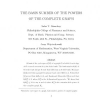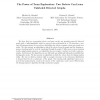26 search results - page 3 / 6 » Distinguishing Cartesian powers of graphs |
DM
1998
13 years 5 months ago
1998
A basis of the cycle space C(G) of a graph G is h-fold if each edge of G occurs in at most h cycles of the basis. The basis number b(G) of G is the least integer h such that C(G) ...
BMCBI
2007
13 years 5 months ago
2007
Background: Construction and interpretation of phylogenetic trees has been a major research topic for understanding the evolution of genes. Increases in sequence data and complexi...
FOCS
1994
IEEE
13 years 10 months ago
1994
IEEE
We show that two cooperating robots can learn exactly any strongly-connected directed graph with n indistinguishable nodes in expected time polynomial in n. We introduce a new typ...
DM
2002
13 years 5 months ago
2002
We consider the vertex-isoperimetric problem for cartesian powers of a graph G. A total order on the vertex set of G is called isoperimetric if the boundary of sets of a given siz...
NJC
2000
13 years 5 months ago
2000
In order to deal with infinite regular trees (or other pointed graph structures) efficiently, we give new algorithms to store such structures. The trees are stored in such a way th...


